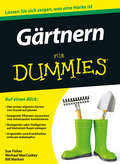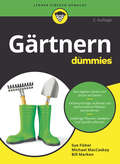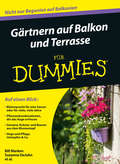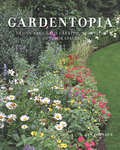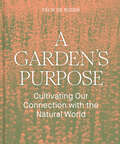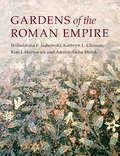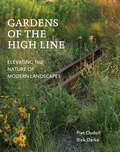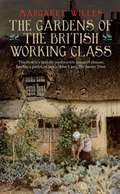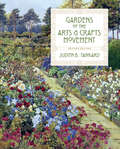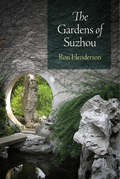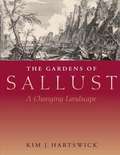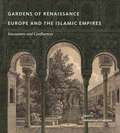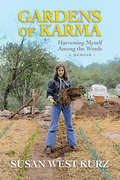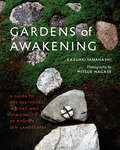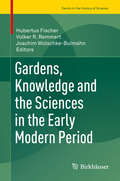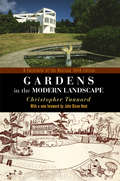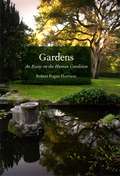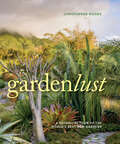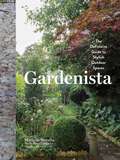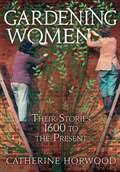- Table View
- List View
Gärtnern für Dummies (Für Dummies)
by Sue Fisher Michael MacCaskey Bill MarkenWenn Sie nicht nur Ihrem grünen Daumen vertrauen wollen Haben Sie ein Stück Erde, das Sie in einen Garten verwandeln möchten, aber außer der Freude an erdverschmierten Händen, sattem Grün und Farbenpracht noch recht wenig Ahnung von Gartenarbeit? Dann ist Gärtnern für Dummies das richtige Buch für Sie! Hier erhalten Sie konkrete Hilfestellung bei der Planung Ihres Gartens und der Wahl der für Sie und Ihr Stück Land passenden Pflanzen. Lernen Sie, wie Sie aus Bäumen, Büschen und Blumen ein harmonisches Ganzes schaffen und mit einjährigen und mehrjährigen Pflanzen Ihren Garten zum Blühen bringen. Außerdem enthält das Buch viele nützliche Tipps zum richtigen Gartengerät, zur Hege und Pflege der Pflanzen, zur Schädlingsbekämpfung und zum Kompostieren.
Gärtnern für Dummies (Für Dummies)
by Sue S. Fisher Michael MacCaskey Bill MarkenHaben Sie ein Stück Erde, das Sie in einen Garten verwandeln möchten, aber außer der Freude an erdverschmierten Händen, sattem Grün und Farbenpracht noch recht wenig Ahnung von Gartenarbeit? Dann ist "Gärtnern für Dummies" das richtige Buch für Sie! Hier erhalten Sie konkrete Hilfestellung bei der Planung Ihres Gartens und der Wahl der für Sie und Ihr Stück Land passenden Pflanzen. Lernen Sie, wie Sie aus Bäumen, Büschen und Blumen ein harmonisches Ganzes schaffen und mit einjährigen und mehrjährigen Pflanzen Ihren Garten zum Blühen bringen. Außerdem enthält das Buch viele nützliche Tipps zum richtigen Gartengerät, zur Hege und Pflege der Pflanzen, zur Schädlingsbekämpfung und zum Kompostieren.
Gärtnern auf Balkon und Terrasse für Dummies (Für Dummies)
by Bill Marken Suzanne DeJohnWer keinen Garten besitzt, muss nicht auf's Gärtnern verzichten. Auch auf Balkon oder Terrasse lässt sich in Töpfen und Kübeln ein kleiner, aber feiner Garten anlegen. Dieses Buch zeigt Ihnen, wie Sie die richtigen Pflanzen auswählen, sie hegen und pflegen und geschickt miteinander kombinieren, sodass sich ein harmonisches Ganzes ergibt. Es macht Vorschläge für Blumenarrangements für eine Saison oder auch eine Bepflanzung, an der Sie viele Jahre Freude haben, ohne viel Arbeit investieren zu müssen.
The Gargoyles of Notre Dame: Medievalism and the Monsters of Modernity
by Michael CamilleMost of the seven million people who visit the cathedral of Notre Dame in Paris each year probably do not realize that the legendary gargoyles adorning this medieval masterpiece were not constructed until the nineteenth century.
The Gargoyles of Notre-Dame: Medievalism and the Monsters of Modernity
by Michael CamilleMost of the seven million people who visit the cathedral of Notre Dame in Paris each year probably do not realize that the legendary gargoyles adorning this medieval masterpiece were not constructed until the nineteenth century. The first comprehensive history of these world-famous monsters, The Gargoyles of Notre-Dame argues that they transformed the iconic thirteenth-century cathedral into a modern monument. Michael Camille begins his long-awaited study by recounting architect Eugène Viollet-le-Duc’s ambitious restoration of the structure from 1843 to 1864, when the gargoyles were designed, sculpted by the little-known Victor Pyanet, and installed. These gargoyles, Camille contends, were not mere avatars of the Middle Ages, but rather fresh creations—symbolizing an imagined past—whose modernity lay precisely in their nostalgia. He goes on to map the critical reception and many-layered afterlives of these chimeras, notably in the works of such artists and writers as Charles Méryon, Victor Hugo, and photographer Henri Le Secq. Tracing their eventual evolution into icons of high kitsch, Camille ultimately locates the gargoyles’ place in the twentieth-century imagination, exploring interpretations by everyone from Winslow Homer to the Walt Disney Company. Lavishly illustrated with more than three hundred images of its monumental yet whimsical subjects, The Gargoyles of Notre-Dame is a must-read for historians of art and architecture and anyone whose imagination has been sparked by the lovable monsters gazing out over Paris from one of the world’s most renowned vantage points.
Gardentopia: Design Basics For Creating Beautiful Outdoor Spaces
by Jan Johnsen“Gardentopia is that rare marriage of the art of landscaping and the technical knowledge of how to compose a landscape—boiled down to readily understood and easily executed actions. This book puts you in the driver’s seat and shows you how to chart the course to your own personal garden utopia.” - Margie Grace, Grace Design Associates Any backyard has the potential to refresh and inspire if you know what to do. Jan Johnsen’s new book, Gardentopia: Design Basics for Creating Beautiful Outdoor Spaces, will delight all garden lovers with over 130 lushly illustrated landscape design and planting suggestions. Ms. Johnsen is an admired designer and popular speaker whose hands-on approach to “co-creating with nature” will have you saying, “I can do that!’ This info-packed, sumptuous book offers individual tips for enhancing any size landscape using ‘real world’ solutions. The suggestions are grouped into five categories that include Garden Design and Artful Accents, Walls, Patios, and Steps and Plants and Planting, among others. Whether you are an experienced gardener or a landscaping novice, Gardentopia will inspire you with tips such as ‘Soften a Corner”, “Paint it Black”, and “Hide and Reveal”.
A Garden's Purpose: Cultivating Our Connection with the Natural World
by Félix de RosenEssays and stories to inspire us to nurture diverse, meaningful relationships with gardens and landscapes. "A garden, as Félix de Rosen suggests in this book, is not a place separate to the world but a tether to it. At a time of increasing ecological and cultural fragmentation and loss, de Rosen reminds us of the importance of the garden as a place of gentle activism and abundance, and gardening as a framework for being with the more-than-human world—engaging with care, reciprocity, and creativity. A Garden's Purpose is an important, timely book." — Georgina Reid, editor of Wonderground Journal and author of The Planthunter: Truth, Beauty, Chaos, and PlantsThe garden provides a powerful, generous way of looking at the world. Through stories and essays, this gracious volume, written in a highly accessible tone, invites readers on a journey to understand gardens as places where we build mutually beneficial relationships with the living world around us.As beautiful spaces, gardens fill us with hope and wonder. As gathering places, they nurture friendships and communities. Thoughtfully crafted, they make us pause and appreciate our surroundings. Full of edible plants, they nourish us. Full of diversity—human and non-human—they connect us with the polychromatic world in which we live. They make us feel at home in our own bodies, in our cities, and on our planet.Each chapter in this book is dedicated to a specific idea or element of the garden, from places where gardens grow (i.e., a driveway in San Francisco, a bathtub as a planter) to garden management (why some lawns need watering every few days, and some gardens can go almost a full year without irrigation) to color and texture (i.e., how fine-textured plants like grasses can be used to unify a space), and everything in between. Hundreds of gardens from all corners of the globe are included, photographed in glorious full color.Perfect for home gardeners, landscape designers, or as a gift for the gardener in your life, this is an ode to the wonder, design, and habitat of gardens, and an inspiration to nurture meaningful relationships with the natural world around us.
Gardens of the Roman Empire
by Wilhelmina F. Jashemski Kathryn L. Gleason Kim J. Hartswick Amina-Aïcha MalekIn Gardens of the Roman Empire, the pioneering archaeologist Wilhelmina F. Jashemski sets out to examine the role of ancient Roman gardens in daily life throughout the empire. This study, therefore, includes for the first time, archaeological, literary, and artistic evidence about ancient Roman gardens across the entire Roman Empire from Britain to Arabia. Through well-illustrated essays by leading scholars in the field, various types of gardens are examined, from how Romans actually created their gardens to the experience of gardens as revealed in literature and art. Demonstrating the central role and value of gardens in Roman civilization, Jashemski and a distinguished, international team of contributors have created a landmark reference work that will serve as the foundation for future scholarship on this topic.
Gardens of the High Line: Elevating the Nature of Modern Landscapes
by Piet Oudolf Rick DarkeThe Gardens of the High Line is the first book devoted to the plants and planting design of New York City's iconic High Line. In its sumptuous pages, Piet Oudolf, who designed the original plantings, and Rick Darke, a leading voice in sustainable horticulture, reveal why the High Line is such an iconic example of landscape design.
The Gardens of the British Working Class
by Margaret WillesThis magnificently illustrated people's history celebrates the extraordinary feats of cultivation by the working class in Britain, even if the land they toiled, planted, and loved was not their own. Spanning more than four centuries, from the earliest records of the laboring classes in the country to today, Margaret Willes's research unearths lush gardens nurtured outside rough workers' cottages and horticultural miracles performed in blackened yards, and reveals the ingenious, sometimes devious, methods employed by determined, obsessive, and eccentric workers to make their drab surroundings bloom. She also explores the stories of the great philanthropic industrialists who provided gardens for their workforces, the fashionable rich stealing the gardening ideas of the poor, alehouse syndicates and fierce rivalries between vegetable growers, flower-fanciers cultivating exotic blooms on their city windowsills, and the rich lore handed down from gardener to gardener through generations. This is a sumptuous record of the myriad ways in which the popular cultivation of plants, vegetables, and flowers has played-and continues to play-an integral role in everyday British life.
Gardens of the Arts and Crafts Movement: Revised Second Edition
by Judith B. TankardIn this revised edition of Gardens of the Arts and Crafts Movement, landscape scholar Judith B. Tankard surveys the inspirations, characteristics, and development of garden design during the movement. Tankard presents a selection of houses and gardens of the era from Great Britain and adds new examples from North America. With almost 300 illustrations and photographs, and an emphasis on the diversity of designers who helped forge the movement, this book is an essential resource for this truly distinct approach to garden design.
The Gardens of Suzhou (Penn Studies in Landscape Architecture)
by Ron HendersonSuzhou, near Shanghai, is among the great garden cities of the world. The city's masterpieces of classical Chinese garden design, built from the eleventh through the nineteenth centuries, attract thousands of visitors each year and continue to influence international design. In The Gardens of Suzhou, landscape architect and scholar Ron Henderson guides visitors through seventeen of these gardens. The book explores UNESCO world cultural heritage sites such as the Master of the Nets Garden, Humble Administrator's Garden, Lingering Garden, and Garden of the Peaceful Mind, as well as other lesser-known but equally significant gardens in the Suzhou region.Unlike the acclaimed religious and imperial gardens found elsewhere in Asia, Suzhou's gardens were designed by scholars and intellectuals to be domestic spaces that drew upon China's rich visual and literary tradition, embedding cultural references within the landscapes. The elements of the gardens confront the visitor: rocks, trees, and walls are pushed into the foreground to compress and compact space, as if great hands had gathered a mountainous territory of rocky cliffs, forests, and streams, then squeezed it tightly until the entire region would fit into a small city garden.Henderson's commentary opens Suzhou's gardens, with their literary and musical references, to non-Chinese visitors. Drawing on years of intimate experience and study, he combines the history and spatial organization of each garden with personal insights into their rockeries, architecture, plants, and waters. Fully illustrated with newly drawn plans, maps, and original photographs, The Gardens of Suzhou invites visitors, researchers, and designers to pause and observe astonishing works from one of the world's greatest garden design traditions.
The Gardens of Sallust: A Changing Landscape
by Kim J. HartswickPleasure gardens, or horti, offered elite citizens of ancient Rome a retreat from the noise and grime of the city, where they could take their leisure and even conduct business amid lovely landscaping, architecture, and sculpture. <P><P>One of the most important and beautiful of these gardens was the horti Sallustiani, originally developed by the Roman historian Sallust at the end of the first century B.C. and later possessed and perfected by a series of Roman emperors. Though now irrevocably altered by two millennia of human history, the Gardens of Sallust endure as a memory of beauty and as a significant archaeological site, where fragments of sculpture and ruins of architecture are still being discovered.
Gardens of Renaissance Europe and the Islamic Empires: Encounters and Confluences (G - Reference, Information and Interdisciplinary Subjects)
by Mohammad GharipourThe cross-cultural exchange of ideas that flourished in the Mediterranean during the sixteenth and seventeenth centuries profoundly affected European and Islamic society. Gardens of Renaissance Europe and the Islamic Empires considers the role and place of gardens and landscapes in the broader context of the information sharing that took place among Europeans and Islamic empires in Turkey, Persia, and India.In illustrating commonalities in the design, development, and people’s perceptions of gardens and nature in both regions, this volume substantiates important parallels in the revolutionary advancements in landscape architecture that took place during the era. The contributors explain how the exchange of gardeners as well as horticultural and irrigation techniques influenced design traditions in the two cultures; examine concurrent shifts in garden and urban landscape design, such as the move toward more public functionality; and explore the mutually influential effects of politics, economics, and culture on composed outdoor space. In doing so, they shed light on the complexity of cultures and politics during the Renaissance.A thoughtfully composed look at the effects of cross-cultural exchange on garden design during a pivotal time in world history, this thought-provoking book points to new areas in inquiry about the influences, confluences, and connections between European and Islamic garden traditions.In addition to the editor, the contributors include Cristina Castel-Branco, Paula Henderson, Simone M. Kaiser, Ebba Koch, Christopher Pastore, Laurent Paya, D. Fairchild Ruggles, Jill Sinclair, and Anatole Tchikine.
Gardens of Renaissance Europe and the Islamic Empires: Encounters and Confluences
by Mohammad GharipourThe cross-cultural exchange of ideas that flourished in the Mediterranean during the sixteenth and seventeenth centuries profoundly affected European and Islamic society. Gardens of Renaissance Europe and the Islamic Empires considers the role and place of gardens and landscapes in the broader context of the information sharing that took place among Europeans and Islamic empires in Turkey, Persia, and India.In illustrating commonalities in the design, development, and people’s perceptions of gardens and nature in both regions, this volume substantiates important parallels in the revolutionary advancements in landscape architecture that took place during the era. The contributors explain how the exchange of gardeners as well as horticultural and irrigation techniques influenced design traditions in the two cultures; examine concurrent shifts in garden and urban landscape design, such as the move toward more public functionality; and explore the mutually influential effects of politics, economics, and culture on composed outdoor space. In doing so, they shed light on the complexity of cultures and politics during the Renaissance.A thoughtfully composed look at the effects of cross-cultural exchange on garden design during a pivotal time in world history, this thought-provoking book points to new areas in inquiry about the influences, confluences, and connections between European and Islamic garden traditions.In addition to the editor, the contributors include Cristina Castel-Branco, Paula Henderson, Simone M. Kaiser, Ebba Koch, Christopher Pastore, Laurent Paya, D. Fairchild Ruggles, Jill Sinclair, and Anatole Tchikine.
Gardens of Karma: Harvesting Myself Among the Weeds, A Memoir
by Susan West KurzIt Began in a Simple Garden . . . and Led to a Spiritual Path. Susan West Kurz's earliest memories began in a garden, where she nurtured herbs and colorful flowers, nibbled sun-drenched vegetables and ripe berries, and danced with her doll, Pinocchio. Later, she landed in another garden, that one in Germany, where she shaped her budding interest into a hugely successful career for international organic and natural skin care products. But for decades, Susan was steeped in another role-one of enabler, support system, and overall back-up singer to the alcoholics who were center stage in her life. The pain of that disease ultimately led her to Anthroposophy, her spiritual path, where she soon recognized she had been headed all along. On her subsequent journey to health and freedom, Susan continues to find inner peace in a garden.
The Gardens of Emily Dickinson
by Judith Farr Louise CarterIn this first substantial study of Emily Dickinson's devotion to flowers and gardening, Judith Farr seeks to join both poet and gardener in one creative personality. She casts new light on Dickinson's temperament, her aesthetic sensibility, and her vision of the relationship between art and nature, revealing that the successful gardener's intimate understanding of horticulture helped shape the poet's choice of metaphors for every experience: love and hate, wickedness and virtue, death and immortality. Gardening, Farr demonstrates, was Dickinson's other vocation, more public than the making of poems but analogous and closely related to it. Over a third of Dickinson's poems and nearly half of her letters allude with passionate intensity to her favorite wildflowers, to traditional blooms like the daisy or gentian, and to the exotic gardenias and jasmines of her conservatory. Each flower was assigned specific connotations by the nineteenth century floral dictionaries she knew; thus, Dickinson's association of various flowers with friends, family, and lovers, like the tropes and scenarios presented in her poems, establishes her participation in the literary and painterly culture of her day. A chapter, "Gardening with Emily Dickinson" by Louise Carter, cites family letters and memoirs to conjecture the kinds of flowers contained in the poet's indoor and outdoor gardens. Carter hypothesizes Dickinson's methods of gardening, explaining how one might grow her flowers today. Beautifully illustrated and written with verve, The Gardens of Emily Dickinson will provide pleasure and insight to a wide audience of scholars, admirers of Dickinson's poetry, and garden lovers everywhere.
Gardens of Awakening: A Guide to the Aesthetics, History, and Spirituality of Kyoto's Zen Landscapes
by Kazuaki TanahashiRenowned artist Kaz Tanahashi reveals the deep, inner spiritual connections that Zen gardens can foster, with over 75 stunning full-color photos of the masterpiece gardens of Kyōto, Japan.Imagine yourself in Kyōto, Japan, gazing at an ancient temple garden. How would you contextualize what you are seeing? What is the history of this centuries-old contemplative art form of Zen gardening? What are its symbols and concepts?Richly illustrated with full-color photographs, Gardens of Awakening guides you through a series of Zen temple gardens, most of which were created from the fourteenth through seventeenth centuries. Some are teeming with plants and flowing water, while others have only rocks and sand. All share in the Zen aesthetics of awakening.Through essays and commentary on Mitsue Nagase&’s striking photographs, beloved Zen artist and translator Kazuaki Tanahashi presents the gardens in terms of seven qualities that arise from Zen practice: direct, ordinary, vigorous, gleaming, pivotal, nondual, and inexhaustible. Relating these qualities to the development of Zen culture and its influence on Japanese art, Gardens of Awakening invites you deep into the heart of Zen.
Gardens, Knowledge and the Sciences in the Early Modern Period
by Hubertus Fischer Volker R. Remmert Joachim Wolschke-BulmahnThis volume of proceedings primarily focuses on the outstanding contributions made by botany and the mathematical sciences to the genesis and development of early modern garden art and garden culture. The many facets of mathematical sciences and botany point to the increasingly "scientific" approach that was being adopted in garden art and garden culture in the early modern period. This development unfolds in interaction with philosophical, religious, political and social processes and beliefs. This volume strikingly shows that such processes are able to make use of the knowledge of nature manifested in gardens for various purposes. The conference that inspired this volume was jointly organized by the Leibniz Universität Hannover's Centre of Garden Art and Landscape Architecture (CGL) and the Bergische Universität Wuppertal's Interdisciplinary Centre for Science and Technology Studies (IZWT).
Gardens in the Modern Landscape: A Facsimile of the Revised 1948 Edition (Penn Studies in Landscape Architecture)
by Christopher TunnardBetween 1937 and 1938, garden designer Christopher Tunnard published a series of articles in the British Architectural Review that rejected the prevailing English landscape style. Inspired by the principles of Modernist art and Japanese aesthetics, Tunnard called for a "new technique" in garden design that emphasized an integration of form and purpose. "The functional garden avoids the extremes both of the sentimental expressionism of the wild garden and the intellectual classicism of the 'formal' garden," he wrote; "it embodies rather a spirit of rationalism and through an aesthetic and practical ordering of its units provides a friendly and hospitable milieu for rest and recreation."Tunnard's magazine pieces were republished in book form as Gardens in the Modern Landscape in 1938, and a revised second edition was issued a decade later. Taken together, these articles constituted a manifesto for the modern garden, its influence evident in the work of such figures as Lawrence Halprin, Philip Johnson, and Edward Larrabee Barnes.Long out of print, the book is here reissued in a facsimile of the 1948 edition, accompanied by a contextualizing foreword by John Dixon Hunt. Gardens in the Modern Landscape heralded a sea change in the evolution of twentieth-century design, and it also anticipated questions of urban sprawl, historic preservation, and the dynamic between the natural and built environments. Available once more to students, practitioners, and connoisseurs, it stands as a historical document and an invitation to continued innovative thought about landscape architecture.
Gardens: An Essay on the Human Condition
by Robert Pogue HarrisonHumans have long turned to gardens -- both real and imaginary -- for sanctuary from the frenzy and tumult that surrounds them. Those gardens may be as far away from everyday reality as Gilgamesh's garden of the gods or as near as our own backyard, but in their very conception and the marks they bear of human care and cultivation, gardens stand as restorative, nourishing, necessary havens. With "Gardens", Robert Pogue Harrison graces readers with a thoughtful, wide-ranging examination of the many ways gardens evoke the human condition. Moving from from the gardens of ancient philosophers to the gardens of homeless people in contemporary New York, he shows how, again and again, the garden has served as a check against the destruction and losses of history.
Gardenlust: A Botanical Tour of the World's Best New Gardens
by Christopher Woods“A beautiful tour through some of the loveliest gardens in the world!” —Peter H. Raven, President Emeritus at Missouri Botanical Garden A steep hillside oasis in Singapore, a garden distinguished by shape and light in Marrakech, a haunting tree museum in Switzerland—these are just a few of the extraordinary outdoor havens visited in Gardenlust. In this sumptuous global tour of modern gardens, intrepid plant expert Christopher Woods spotlights 50 modern gardens that push boundaries and define natural beauty in significant ways. Featuring both private and public gardens, this journey makes its way from the Americas and Europe to Australia and New Zealand, with stops in Asia, Africa, and the Arabian Peninsula. Along the way, you'll learn about the people, plants, and stories that make these iconic gardens so lust-worthy. As inspiring as it is insightful, Gardenlust will delight your passion for garden inspiration—and the many places it grows.
Gardenista: The Definitive Guide to Stylish Outdoor Spaces (Remodelista)
by Michelle SlatallaNamed a Best Gift Book for Gardeners by The New York Times Book Review, Los Angeles Times, San Francisco Chronicle, Seattle Times, Domino magazine, and Goop. The team behind the inspirational design sites Gardenista.com and Remodelista.com presents an all-in-one manual for making your outdoor space as welcoming as your living room. Tour personality-filled gardens around the world and re-create the looks with no-fail planting palettes. Find hundreds of design tips and easy DIYs, editors&’ picks of 100 classic (and stylish) objects, a landscaping primer with tips from pros, over 200 resources, and so much more.
Gardening Women: Their Stories From 1600 to the Present
by Dr Catherine HorwoodFrom Flora, Roman goddess of plants, to today's gardeners at Kew, women have always gardened. Women gardeners have grown vegetables for their kitchens and herbs for their medicine cupboards. They have been footnotes in the horticultural annals for specimens collected abroad. They taught young women about gardening twenty-five years before women's horticultural schools officially existed. And their influence on the style of our gardens, frequently unacknowledged, survives to the present day.From these triumphs to the battles fought against male-dominated institutions, from the horticultural pioneers to the bringers of change in society's attitudes, this book is a celebration of the best of the species -- gardening women.
Gardening Without Irrigation: or Without Much, Anyway
by Steve SolomonHighly informative book on gardening in arid areas.
